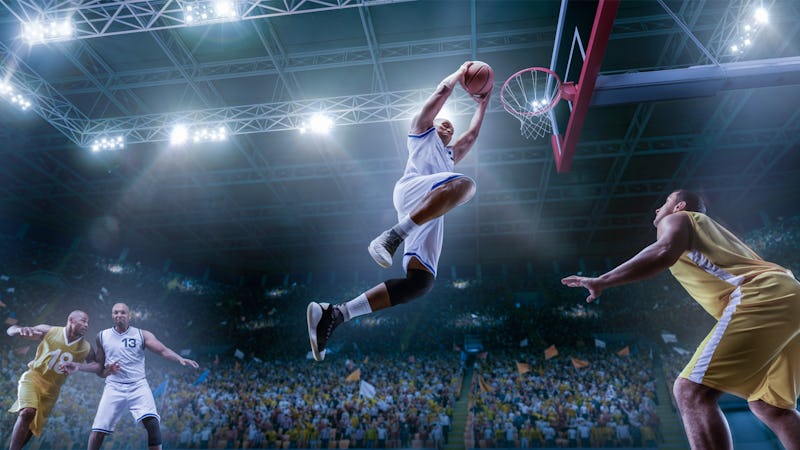Consumers and advertisers are welcoming back the return of live sports. The NBA, NFL, MLB and many other leagues celebrated their post-COVID comebacks beginning late summer and early fall 2021.
Creating a major advertising opportunity for brands looking to reach a demographic that has been out of range for so long - sports fans.
In this article, we'll highlight everything you need to know about advertising to sports fans.
Why Brands should Advertise to Sports Fans
The sports fan demographic is a very desirable target for advertisers because sports fans are highly influenced by advertising.
In fact, they are 42% more likely to agree that "advertising influences my buying decisions" than the general population.
To put it simply, sports fans are less resistant to advertising - dare we say they may even welcome ads as an opportunity to learn about new brands or products they hadn't considered before.
And, there’s a lot of them.
During a June 2021 poll in the United States, 25% of respondents said they were sports enthusiasts. That’s millions of potential buyers interested in hearing about your product or service.
Brands should consider advertising to sports fans because they are highly receptive to marketing messages and are a significant proportion of the population. In June 2021, 25% of respondents in the United States said they were strongly interested in sports and games, which equates to approximately 83 million people. What's more, sports viewership statistics have continued to remain strong with Super Bowl LV garnering over 99.9 million viewers, up from 98.2 million the previous year.
Moreover, the sports gambling industries have grown exponentially in recent years with US sports betting handle increasing by a whopping 60% between 2019 and 2020. This has opened up new opportunities for brands to reach and engage with sports fans through sports betting-related advertising.
Ultimately, the sports fan demographic is an incredibly valuable target for advertisers due to their receptiveness to marketing messages and the sheer number of people in the group. As such, brands should consider investing more heavily into advertising to sports fans to reach new audiences who are likely to be more receptive to their campaigns than other demographics.
The growth of sports gambling and a large number of sports fans make it an ideal opportunity for brands to take advantage of, so don't miss out on this chance now!
Learn more about The Ins and Outs of Sports Marketing Agencies

Sports Fans Buyer Persona
Dodge wasteful ad spend by fine-tuning ad targeting to sports fans demographics by major league.
Overall, sports fans are more likely to be male, have a college degree and earn over $75k annually. They also lean Republican in their political affiliation.
Colormatics are no rookies when it comes to targeting sports enthusiasts. Here are current demographics for sports fans by major league.
Baseball Fans:
- Male: 57% | Female: 43%
- Ages 18-49 years old: 66%
- College educated: 67%
- Household income over $75k/year: 47%
- Political affiliation (Republican): 38%
Baseball fans tend to be male minorities living outside big cities. They have a higher income than the general population, with over 60% earning more than $75,000 annually.
Baseball fans are the oldest sports fan demographic across all sports with a median age of 47.
Basketball Fans:
- Male: 61% | Female: 39%
- Ages 18-34 years old: 58%
- College educated 65%:
- Household income over $100k/year
- Political affiliation (Democrat): 42%
Basketball fans are younger than baseball fans, with a median age of 34, making them more likely to be part of Gen Z or Millennials. They also tend to be from big cities or suburbs.
When compared to the sports fan persona as a whole, basketball fans are notably more diverse in terms of ethnicity. Over one-third of all NBA fans identify as something other than white, making basketball fans the most ethnically diverse sports fanbase.
American Football Fans:
- Male 59 % | Female 41%
- Ages 18-49 years old: 70%
- College educated: 68%
- Household income over $75k/year: 54%
- Political affiliation (Republican): 47%
American football fans, on the other hand, are older than any other sports fanbase. More than half (55%) of all NFL fans are over the age of 35.
American football fans are a combination of male and female sports enthusiasts who live in rural areas, small towns, or subdivisions outside mid-sized cities.
They have the highest income of all sports fan demographics, with over 70% earning more than $75,000 annually.

Advertisements Sports Fans Pay Attention To
When it comes to winning sports fan’s attention, it's not surprising they are more likely to pay attention to ads that remind them of the game or their favorite team.
Engage sports fans with creative visuals and messaging that taps into the emotional connection people have with sports.
Humor
Humor is also a successful tactic when appealing to sports fans. Some examples include ads that show players in humorous situations or ones where a brand takes on the persona of a sports commentator.
Athletes
Another approach is using athletes as spokespeople for sports brands. A sports celebrity endorsement can be extremely valuable for marketers trying to connect with sports fans, but only if the athlete is someone that appeals to sports enthusiasts.
Team Spirit
Tap into the excitement and energy by getting fans involved in content creation. Like Budwesier did with the NFL for an unforgettable night of hockey.
Colormatics helped produce and promote eye-popping Facebook and Twitter posts in real-time—all while the excitement of 10,000 cups lit up the arena RED whenever the home team scored a goal. With thousands of shares and likes, fans both in the stadium and at home felt the energy.
For more advice on advertising to sports fanatics: hit that pink chat box in the bottom right corner to speak with a Colormatics team member.
Sports Advertising Opportunities
Now that we know who to target and what type of content they engage with, where should the ads be placed for maximum impact?
Here are the three most sought after types of media placements for maximum exposure to sports fans.
Traditional TV Commercials
Nielsen's 2018 report found that traditional sports viewers are twice as likely to be reached by sports-related ads on television than any other medium. When it comes to TV advertising, sports fans prefer ads that feature athletes or teams in action over those that focus on product features or benefits.
OTT Advertising
Sports fans can also benefit from digital sports advertising for branding purposes. According to Nielsen, sports fans spend nearly 60% more time watching sports on digital devices than the general population. In fact, they're so engaged that they account for 71% of all sports viewership across digital platforms.
OTT advertising is creating a unique opportunity to reach a digitally savvy millennial audience who have an affinity for investing.
Virtual Advertising
During a live broadcast of a sports event, advertising boards placed on the field provide for an extremely visible yet non-intrusive method to advertise. Providing several advantages over traditional field-sideboards, including:
Higher visibility. Virtual signs are larger and easier to see than their real world counterparts; giving advertisers a bigger bang for their buck
Lower cost. Since virtual ads can be targeted at specific audiences based on location (in home vs away games), they offer increased reach while still remaining affordable. This enables marketers to achieve more with smaller budgets.
Easier integration. Unlike physical signage which must be shipped & installed before each game, virtual advertisements can be activated remotely via software plug-ins that allow brands to change copy as often as desired without having to take time out for on-site visits.
For these reasons, virtual sports advertising is becoming an increasingly popular way for brands to reach sports fans.
Live Streaming
Sports fans love to use live streaming video because it allows them to watch their favorite games in real-time, no matter where they are. With live streaming, fans can keep up with their favorite teams, players, and matches from anywhere in the world, as long as they have an internet connection. Live streaming video also provides fans with a more interactive viewing experience, allowing them to engage with other fans in real-time, share their reactions and comments, and feel like they are part of the action. However, live streaming requires a lot of technical expertise, equipment, and resources to ensure a high-quality, reliable stream. That's why many sports fans rely on companies that specialize in live streaming to provide them with the best possible viewing experience. These companies have the necessary expertise and resources to ensure that the live stream runs smoothly, without buffering or technical difficulties, allowing fans to enjoy their favorite sports events without any interruptions.
Using an Athlete's Personal Brand
Using an athlete's brand for marketing is a powerful strategy to reach and engage sports fans. This approach leverages the athlete's popularity, credibility, and broad reach to connect with potential customers. Here's an in-depth look into why and how this tactic is effective.
1. Access to a Large and Engaged Audience:
Sports fans constitute a vast, global audience with an intense loyalty and passion for their favorite sports and athletes. By aligning your marketing strategy with a popular athlete, your brand gets exposure to a massive and already-engaged demographic.
2. High Level of Influence:
Athletes often hold a significant influence over their fans, who look up to them as role models. They have the power to shape attitudes, inspire behavior, and drive consumer choices. Therefore, when a respected athlete endorses a product or service, it lends a strong credibility and appeal to the brand.
3. Emotional Connection:
Fans have a deep emotional connection with their favorite athletes. They celebrate their victories and empathize with their challenges. By partnering with an athlete, a brand can tap into this emotional bond, leading to a stronger customer-brand relationship.
4. Values Alignment:
Athletes often represent values like hard work, resilience, discipline, and teamwork - qualities that resonate with many consumers. Brands associated with such athletes can effectively communicate these values, positioning themselves as entities that uphold and promote these qualities.
5. Increased Social Media Visibility:
In the digital age, many athletes have substantial social media followings. Utilizing an athlete's brand in marketing can exponentially increase a company's visibility online. Each share, like, or comment from the athlete or their fans can significantly amplify the reach of the campaign.
6. Enhance Brand Image:
Being associated with a renowned athlete can improve a brand's image. It signals to consumers that the brand is high-quality and trustworthy, enough so that a prominent figure is willing to stake their reputation on it. It can also imply that the brand is successful and popular, further attracting potential customers.
7. Targeted Marketing:
Using an athlete's brand can allow for more targeted marketing. Depending on the sport, the athlete, and their fan base, companies can tailor their messages to specific demographic or psychographic segments.
8. Boost Sales:
Finally, all these factors combine to boost sales. Greater visibility, an enhanced brand image, emotional connection, and targeted messaging all contribute to increased customer interest and ultimately, higher sales.
However, while using an athlete's brand can have numerous benefits, it's essential to approach this strategy carefully. Brands must ensure that the athlete aligns with their values, and any partnership should feel authentic to consumers. Brands should also be prepared for potential risks, such as a scandal involving the athlete, which could reflect negatively on the associated brand.

Final Thoughts
Understanding sports fan demographics is essential for brands looking to connect with this highly sought after market.
Hit the pink chat box in the bottom right hand corner to learn more about sports advertising. We’re happy to walk through our discovery process to make advertising easy.
Learn more about current Marketing Trends.


